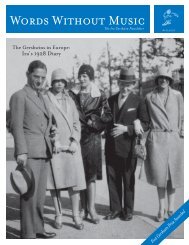Words Without Music - George and Ira Gershwin
Words Without Music - George and Ira Gershwin
Words Without Music - George and Ira Gershwin
Create successful ePaper yourself
Turn your PDF publications into a flip-book with our unique Google optimized e-Paper software.
The songs, chosen by Ludwig from the American<br />
in Paris movie as well as from the entire <strong>Gershwin</strong><br />
canon, include “Funny Face,” “(I’ll Build a)<br />
Stairway to Paradise,” “Clap Yo’ H<strong>and</strong>s,”<br />
“’S Wonderful,” “Love Walked In,” “Fascinating<br />
Rhythm” <strong>and</strong> “They All Laughed.”<br />
“They All Laughed.” Among the rarities are “Wake Up,<br />
Brother, <strong>and</strong> Dance,” in its theatrical debut at the Alley (it was<br />
to have been sung by Fred Astaire in the 1937 film Shall We<br />
Dance, but was not used), “Meadow Serenade” (from Strike Up<br />
the B<strong>and</strong>, 1927), “Just Another Rhumba” (written for but not<br />
used in the 1938 film The Goldwyn Follies), “Delishious” (the title<br />
song from the 1931 film Delicious), “Home Blues” (from the<br />
1929 musical Show Girl, with the music based on the blues<br />
theme of the 1928 symphonic work An American in Paris) <strong>and</strong><br />
“The Bad, Bad Men” (dropped from 1924’s Lady, Be Good! during<br />
its pre-Broadway tryout.)<br />
An American in Paris was directed by Gregory Boyd, the Alley’s<br />
longtime artistic director. Rob Berman’s vocal <strong>and</strong> dance<br />
arrangements (including an abridged version of the movie’s title<br />
ballet) <strong>and</strong> Doug Besterman<br />
<strong>and</strong> Larry Blank’s orchestrations<br />
were performed by a<br />
21-piece onstage orchestra.<br />
The choreography for the<br />
numerous dance sequences<br />
was provided by R<strong>and</strong>y<br />
Skinner. Douglas Schmidt’s<br />
scenery <strong>and</strong> Carrie Robbins’<br />
costumes captured the ambience<br />
of Paris in the 1950s.<br />
The show, which opened at the Alley on May 18 after three<br />
weeks of previews, was scheduled to run through June 1 but<br />
was extended to June 22.<br />
See it Online!<br />
Congratulations to<br />
American in Paris<br />
cast members Erin Crouch<br />
<strong>and</strong> Jeffry Denman,<br />
who were married<br />
in New York<br />
on August 17, 2008.<br />
Clips from the show can be seen online at http://<br />
youtube.com/watch?v= _R-aM3cQjaE&feature=related.<br />
Jeffry Denman’s not-to-be-missed<br />
rap video about the show is also available online at<br />
http://youtube.com/watch?v= 7lhyFM9GTmE.<br />
“I Have an Idea for How to Approach the <strong>Music</strong>al”<br />
Behind the Scenes with Ken Ludwig<br />
[<strong>Words</strong> <strong>Without</strong> <strong>Music</strong> editor Abigail Kimball spoke<br />
with playwright Ken Ludwig in June 2008.]<br />
Q: Can you tell us about the genesis of the show The <strong>Gershwin</strong>s’<br />
An American in Paris?<br />
KL: Over the years I had heard that there were different<br />
readings of [a stage version of An American in Paris]. A decade<br />
<strong>and</strong> a half after Crazy for You – I can’t be exactly precise – I<br />
remember someone bringing up the fact that there was another<br />
attempt to do it by someone in Engl<strong>and</strong> <strong>and</strong> that it had<br />
fallen through. I said in passing to someone, “If the opportunity<br />
ever becomes available, I’d be interested in being<br />
involved. I have an idea for how to approach the musical.”<br />
And not long thereafter, someone from the <strong>Gershwin</strong> family<br />
called me <strong>and</strong> said, “Whatever we were working on didn’t<br />
work out <strong>and</strong> we would be interested in hearing what you<br />
have to say about it.” I’ve always had this idea of not following<br />
the story of the movie, but writing a whole new show, a<br />
new musical comedy, about an American in Paris – but not<br />
Gene Kelly after World War II. The way I approached it<br />
was to do a musical called An American in Paris about an<br />
American, in this case a woman, who goes to Paris, <strong>and</strong> to<br />
set it in the world of the movies in the 1950s. I love the<br />
idea of movie-making in that era. It’s very much the world<br />
of Singin’ in the Rain.<br />
Q: You always planned to have your American be a woman?<br />
KL: I did. I thought that was a fun twist. I’ve become convinced<br />
over time that probably 99 percent of the people<br />
that walk into a theater to see a show called An American in<br />
Paris really don’t know what the original movie was about<br />
<strong>and</strong> don’t know whether it’s a departure or not. They just<br />
want to see a show that has a good, strong emotional core,<br />
that’s funny, that’s colorful, has great music, good lines,<br />
that’s a great night at the theater. Ultimately, whether it’s<br />
Continued on page 8<br />
The <strong>Ira</strong> <strong>Gershwin</strong> Newsletter 7





